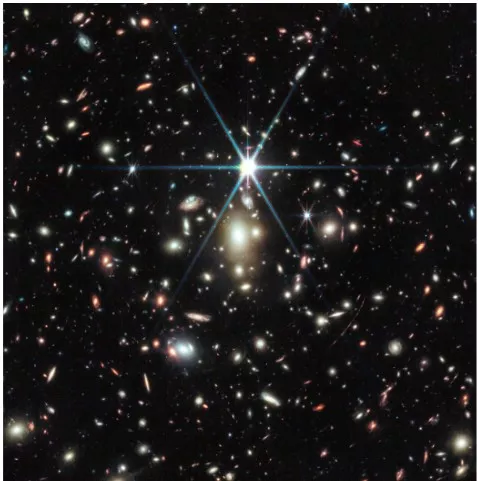NASA’s James Webb Space Telescope (JWST) has confirmed and expanded upon the Hubble Space Telescope’s discovery of “Earendel”, the most distant star ever observed — shining just one billion years after the Big Bang.
About Earendel: The ‘Morning Star’ of the Early Universe

- Meaning: The name Earendel means “morning star” or “rising light.”
- Nature: It is a massive B-type star, more than twice as hot as the Sun and nearly one million times more luminous.
- Uniqueness: Unlike most distant stars that blend into their host galaxies, Earendel’s light is individually visible due to a natural cosmic phenomenon — gravitational lensing.
- Location: Earendel lies within the Sunrise Arc galaxy, one of the most strongly magnified galaxies observed from the universe’s first billion years.
Sunrise Arc galaxy
- A very distant, gravitationally lensed galaxy that hosts Earendel.
- It provides a natural laboratory for studying the earliest star clusters, stellar nurseries, and galactic evolution at the dawn of the universe.
|
Role of Gravitational Lensing in Discovery
- Concept: Gravitational lensing is a phenomenon in which light from a distant celestial object (like a galaxy) is bent by the gravitational field of a massive object (like another galaxy or black hole) lying between the source and the observer.
- This happens because, according to Einstein’s General Theory of Relativity, mass curves spacetime, and light follows this curved path — similar to how a glass lens bends light.
Discovery Mechanism
- Alignment: Earendel’s visibility results from its alignment behind a galaxy cluster named WHL0137-08, located between Earth and the distant star.
- Gravitational Lensing: The cluster’s immense gravity bends and magnifies light from objects behind it — acting as a cosmic magnifying glass.
- Amplification: This natural lensing boosted Earendel’s brightness by over 4,000 times, making it appear as a single bright point that JWST could capture with precision.
Scientific Importance
- Earendel’s Age: It shone 1 billion years after the Big Bang, making it the farthest individual star ever seen.
- Comparative Milestones:
-
- Earendel: 1 billion years post–Big Bang.
- Quyllur (Red Giant) – Detected by Webb: 3 billion years post–Big Bang.
- Hubble’s earlier records: 4 billion years post–Big Bang.
- Cosmic Insight: Studying Earendel helps scientists understand:
- Stellar evolution in the early universe.
- Transition from the “cosmic dark ages” to the formation of the first galaxies.
- Early chemical composition and metallicity of stars.
Hubble Space Telescope (HST)
- Launch: Launched in 1990 by NASA and ESA; placed in low Earth orbit (~547 km).
- Observation Range: Works in visible, ultraviolet, and near-infrared wavelengths.
- Major Discoveries: Captured the Hubble Deep Field, estimated the Universe’s age (~13.8 billion years), and provided evidence for dark energy.
James Webb Space Telescope (JWST)
- Launch: Launched on December 25, 2021, by NASA, ESA, and CSA (Canadian Space Agency).
- Orbit & Position: Operates at the Sun–Earth L2 point (~1.5 million km from Earth).
- Observation Range: Specializes in infrared wavelengths, allowing it to see through cosmic dust.
- Mirror Design: Features a 6.5-meter gold-coated mirror, much larger and more sensitive than Hubble’s 2.4-meter mirror.
- Scientific Achievements: Captured images of SMACS 0723 (Galaxy Cluster), Pillars of Creation.
- Objective: Studies early galaxy formation, exoplanet atmospheres, and the origins of stars and elements.
|
![]() 8 Oct 2025
8 Oct 2025



